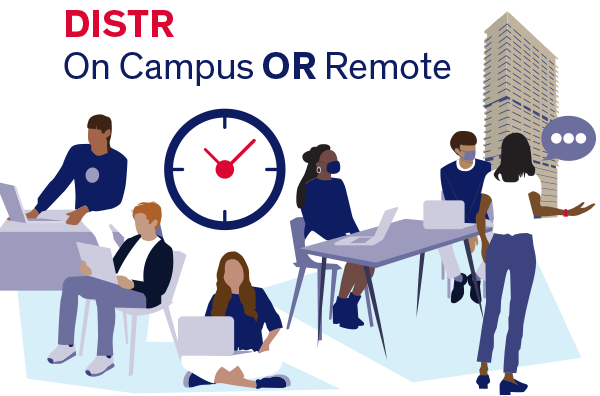On Campus or Remote (DISTR)
Also known as SYNCHRONOUS DISTRIBUTED
Synchronous distributed (DISTR)
These courses mix on campus and remote students, with on campus students being face-to-face with the instructor and remote students participating simultaneously via live streaming technology.
column 1
- A synchronous distributed course is organized around scheduled meeting days and times as listed on the UIC schedule of classes. Scheduled course activities may include weekly lectures, discussions, secondary sections led by teaching assistants, and exams.
- Multiple CRNs will be created per course, one for on campus students and one for online students, enabling students to enroll in the course modality of their choosing and instructors to know in advance of the start of the course how many and which students will be participating in each modality.
- Instructors and teaching assistants may also offer online office hours and review sessions as indicated in the syllabus or course announcements.
- Synchronous distributed courses will require remote students to join class sessions in real time utilizing video conferencing technologies such as Blackboard Collaborate or Zoom. In addition, these courses may use educational technology such as Blackboard and other digital tools for class activities, communications, and assignments completed outside of the scheduled times.
- Instructors may choose to video record class meetings to facilitate access for students who are excused from attending class (check with instructor regarding course policy).
column 2

- Notably, students must commit to a mode of learning, either on campus or online, when they enroll in the course.
- This instructional mode is only feasible in the following classrooms: Lecture Center C classrooms (C1, C3, C4, and C6) and ARC 136, 137, 240, 241, 242. Instructors must consult with Course Management & Academic Space Scheduling in advance to reserve these rooms if planning to teach in this mode.
Designing a Synchronous Distributed Course
The following are resources to help you design a student-centered, engaging Synchronous Distributed Course:
column 1
- Schedule an instructional design consultation to begin mapping out your course including learning objectives, assessments, learning activities, and instruction.
- Utilize a course map to help guide your course design using backward design principles.
column 2
- Request a course template be copied into your course to get you started at Blackboard Learn – Course Site Template.
Course Design and Accessibility Resources
Teaching a Synchronous Distributed Course
Recommended Ed Tech Tools
-
Zoom
- Use Zoom in the Classroom
- Schedule Zoom Meetings in Blackboard
- Find Zoom Recordings in Blackboard
- Take Attendance in Zoom Sessions
- Save Zoom Recordings to Echo360
- Zoom Faculty and Staff User Guide
- UIC Zoom Remote Teaching FAQ
- UIC Breakout Room Basics
- Full Guide on using Breakout Rooms
- Should I use Blackboard Collaborate or Zoom?
-
Blackboard
-
Echo360
- Schedule Classroom Recordings
- Checklist to Ensure Correct Recordings
- How can I live stream using Echo360?
- Working with Slides and Presentations
- Poll Students in the Classroom
- Use Learning Analytics in the Classroom
- View Student Engagement Analytics
- Use Echo360 with Powerpoint
- Live Streaming with Universal Capture
- UIC Universal Capture Quick Guide
- UIC Echo360 FAQ
-
Google
-
Other Tools
-
Virtual Interactive Whiteboards
-
Polling solutions